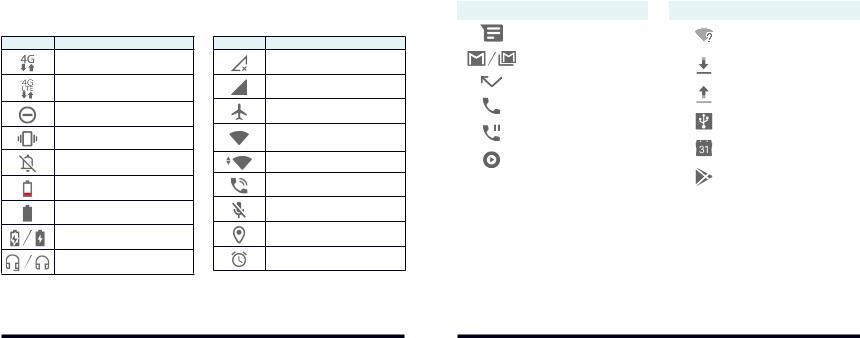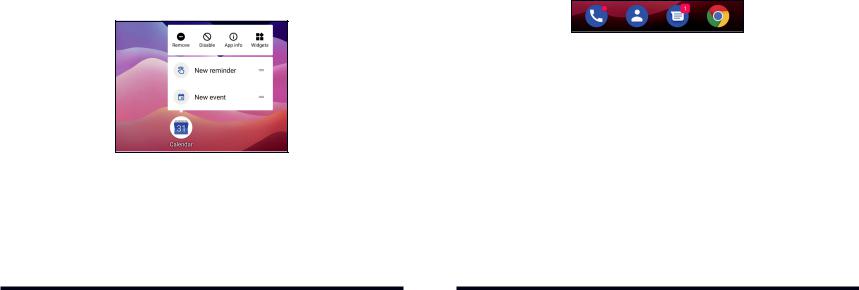ZTE Avid 579 User Guide

ZTE Avid 579
USER GUIDE
1

Thank you for choosing Consumer Cellular!
We know you’re excited to use your new ZTE Avid 579, and this user guide will help you get familiar with it, so you can start using it as soon as possible. Each section includes instructions and pictures to make it easy to start using your device. If you would like to learn more, turn to the back of this guide, where you’ll find the SUPPORT section.
We’re always happy to help you!
Need More Information?
Visit our website at ConsumerCellular.com/Help
Call us at (800) 686-4460
TABLE OF CONTENTS |
|
Getting Started ................................................................................ |
10 |
Installing a microSDXC™ Card .................................................................... |
10 |
Charging the Battery...................................................................................... |
10 |
Extending the Battery Life............................................................................. |
11 |
Powering Your Phone On/Off...................................................................... |
12 |
Setting Up Your Phone for the First Time................................................ |
12 |
Locking/Unlocking the Screen and Keys................................................ |
13 |
Using the Touch Screen................................................................................ |
14 |
Getting to Know Your Phone ...................................................................... |
15 |
Key Functions .................................................................................................. |
17 |
Getting to Know the Home Screen........................................................... |
18 |
Personalizing.................................................................................... |
20 |
Changing the System Language.............................................................. |
20 |
Setting the Date and Time......................................................................... |
20 |
Changing the Ringtone, Notification Sound, or Alarm Sound.......... |
21 |
Turning System Sounds On/Off.................................................................. |
21 |
Adjusting Volumes........................................................................................ |
22 |
Switching to Silent or Vibration Mode.................................................... |
22 |
Using Do Not Disturb Mode....................................................................... |
23 |
2 |
1 |

TABLE OF CONTENTS |
|
Applying New Wallpapers........................................................................... |
24 |
Setting the Home Screen Options........................................................... |
24 |
Using Night Light........................................................................................... |
25 |
Protecting Your Phone With a Screen Lock.......................................... |
25 |
Protecting Your Phone With Screen Pinning........................................ |
26 |
Knowing the Basics.......................................................................... |
28 |
Phone Status ICONS..................................................................................... |
28 |
Notification Icons........................................................................................... |
29 |
Opening/Closing the Notification Panel................................................ |
29 |
Responding to or Removing a Notification............................................ |
30 |
Using Quick Settings..................................................................................... |
30 |
Managing Shortcuts and Widgets............................................................. |
32 |
Organizing With Folders.............................................................................. |
33 |
Rearranging the Primary Shortcuts........................................................... |
33 |
Using APP Shortcuts..................................................................................... |
34 |
Notification Dots (App Badges).................................................................. |
35 |
Entering Text.................................................................................................... |
36 |
Editing Text....................................................................................................... |
39 |
Opening and Switching Apps.................................................................... |
40 |
TABLE OF CONTENTS |
|
Uninstalling or Disabling an App................................................................ |
41 |
Connecting to Networks and Devices............................................ |
42 |
Connecting to Mobile Networks............................................................... |
42 |
Connecting to Wi-Fi®..................................................................................... |
43 |
Connecting to Bluetooth® Devices.......................................................... |
46 |
Connecting to Your Computer via USB................................................... |
48 |
Using the microSDXC Card as Portable or Device Storage............. |
49 |
Sharing Your Mobile Data Connection................................................... |
52 |
Connecting to Virtual Private Networks................................................. |
55 |
Phone Calls....................................................................................... |
57 |
Placing and Ending Voice Calls................................................................. |
57 |
Answering or Rejecting Voice Calls......................................................... |
58 |
Using Real-Time Text (RTT)........................................................................ |
59 |
Working With the Call History...................................................................... |
61 |
Calling Your Contacts.................................................................................... |
63 |
Checking Voicemail....................................................................................... |
63 |
Using Options During a Call....................................................................... |
64 |
Managing Multi-party Calls......................................................................... |
65 |
Adjusting Your Call Settings....................................................................... |
66 |
2 |
3 |

TABLE OF CONTENTS |
|
Contacts............................................................................................ |
72 |
Adding a New Contact................................................................................. |
72 |
Setting Up Your Own Profile....................................................................... |
72 |
Importing, Exporting, and Sharing Contacts.......................................... |
73 |
Working With Favorite Contacts................................................................ |
74 |
LABELing Your Contacts.............................................................................. |
75 |
Searching for a Contact............................................................................... |
76 |
Managing Emergency Contacts................................................................ |
76 |
Editing Contacts.............................................................................................. |
77 |
Web Accounts................................................................................... |
79 |
Adding or Removing Accounts.................................................................. |
79 |
Configuring Account Sync.......................................................................... |
80 |
Gmail................................................................................................. |
81 |
Setting Up AN Email Account...................................................................... |
81 |
Checking Your Emails.................................................................................... |
81 |
Writing and Sending an Email.................................................................... |
82 |
Responding to an Email............................................................................... |
82 |
Editing or Removing an Email Account................................................... |
84 |
|
TABLE OF CONTENTS |
Changing General Email Settings |
.............................................................84 |
Messages.......................................................................................... |
85 |
Opening the Messages Screen................................................................. |
85 |
Sending a Message....................................................................................... |
85 |
Replying to a Message................................................................................. |
87 |
Forwarding a Message................................................................................. |
87 |
More Message Options................................................................................ |
88 |
Web Browser..................................................................................... |
89 |
Opening the Browser.................................................................................... |
89 |
Using Multiple Browser Tabs...................................................................... |
89 |
Downloading Files........................................................................................ |
90 |
Changing Browser Settings....................................................................... |
90 |
Camera.............................................................................................. |
91 |
Capturing a Photo........................................................................................... |
91 |
Using Manual Camera Mode..................................................................... |
92 |
Using PANORAMA Mode............................................................................. |
93 |
Recording a Video......................................................................................... |
93 |
Customizing Camera Settings.................................................................... |
94 |
4 |
5 |

TABLE OF CONTENTS |
|
YT Music............................................................................................ |
97 |
Viewing Your Music Library......................................................................... |
97 |
Playing Music................................................................................................... |
97 |
Managing Playlists......................................................................................... |
98 |
Video................................................................................................. |
99 |
Opening the Video Library......................................................................... |
99 |
Playing and Controlling Videos................................................................ |
99 |
Managing Video Files.................................................................................. |
101 |
FM Radio......................................................................................... |
102 |
Scanning and Saving Channels............................................................... |
102 |
Listening to FM Radio................................................................................. |
102 |
Other Options and Settings...................................................................... |
103 |
Voice Recorder................................................................................ |
104 |
Recording a Voice Memo.......................................................................... |
104 |
Playing a Voice Memo................................................................................ |
104 |
Trimming a Voice Memo............................................................................ |
105 |
More Apps....................................................................................... |
106 |
Calculator........................................................................................................ |
106 |
|
TABLE OF CONTENTS |
Clock................................................................................................................ |
106 |
File Manager.................................................................................................. |
107 |
Google Apps.................................................................................................. |
108 |
Google Play™ Store.......................................................................... |
110 |
Browsing and Searching for Apps........................................................... |
110 |
Downloading and Installing Apps............................................................ |
110 |
Creating a Payment Method........................................................................ |
111 |
Managing Your Downloaded Apps......................................................... |
112 |
Settings............................................................................................ |
113 |
Network & Internet......................................................................................... |
113 |
Connected Devices...................................................................................... |
115 |
Apps & Notifications..................................................................................... |
116 |
Battery................................................................................................................ |
117 |
Features............................................................................................................ |
117 |
Display............................................................................................................... |
117 |
Sound................................................................................................................ |
119 |
Storage............................................................................................................. |
119 |
Privacy.............................................................................................................. |
120 |
6 |
7 |

TABLE OF CONTENTS |
|
Location........................................................................................................... |
120 |
Security............................................................................................................ |
120 |
Accounts......................................................................................................... |
123 |
Accessibility................................................................................................... |
123 |
Digital Wellbeing & Parental Controls.................................................... |
123 |
Google............................................................................................................. |
124 |
System............................................................................................................. |
124 |
About Phone.................................................................................................. |
126 |
Upgrading the Phone Software.................................................... |
127 |
Troubleshooting............................................................................. |
128 |
For Your Safety............................................................................... |
133 |
General Safety ............................................................................................. |
133 |
FCC RF Exposure Information (SAR)...................................................... |
134 |
FCC Regulations........................................................................................... |
135 |
Hearing Aid Compatibility (HAC) Regulations for Mobile Phones.136 |
|
Distractions..................................................................................................... |
138 |
Product Handling.......................................................................................... |
139 |
Electrical Safety............................................................................................. |
143 |
|
TABLE OF CONTENTS |
CTIA Requirements...................................................................................... |
144 |
Radio Frequency Interference................................................................. |
145 |
Explosive Environments.............................................................................. |
147 |
Specifications................................................................................. |
148 |
Support............................................................................................ |
149 |
Warranty.......................................................................................... |
150 |
8 |
9 |

GETTING STARTED
INSTALLING A microSDXC™ CARD
The microSDXC card can be installed and removed while the phone is turned on. Unmount the microSDXC card before removing it.
1.Place your finger in the slot at the bottom of the back cover to lift and remove the cover.
2.Hold your microSDXC card with the metal contacts facing down and slide it into the microSDXC card slot.
NOTE: Some applications may require a microSDXC card to store certain data on it and to work properly. Therefore, it is recommended that you keep a microSDXC card installed and not remove or replace it unnecessarily.
3.Press the cover gently back into place until you hear a click.
CHARGING THE BATTERY
Your phone’s battery should have enough power for the phone to turn on, find a signal, and make a few calls. You should fully charge the battery as soon as possible.
If the battery is low, there will be a pop-up message on the screen. As you charge your phone, the screen will show the exact battery level on the status bar.
GETTING STARTED
WARNING! Use only ZTE-approved chargers and cables. The use of unapproved accessories could damage your phone or cause the battery to explode.
1.Connect the adapter to the charging jack. Ensure that the adapter is oriented correctly. Do not use force.
2.Connect the charger to a standard AC power outlet. If the phone is on, you’ll see a charging icon, such as  or
or  , appear in the status bar.
, appear in the status bar.
3.Disconnect the charger when the battery is fully charged.
NOTE: If the battery is extremely low, you may be unable to power on the phone even when it is being charged. In this case, try again after charging the phone for at least 20 minutes. Contact customer service if you still cannot power on the phone after prolonged charging.
EXTENDING THE BATTERY LIFE
Active applications, screen brightness levels, Bluetooth and Wi-Fi usage, and GPS functionality can drain your battery. You can follow the helpful tips below to conserve your battery power:
•Reduce the screen backlight time.
•Lower the screen brightness.
•Turn auto sync and Bluetooth off when not in use.
•Disable the GPS function when not in use. Most applications using this function will periodically query the GPS satellites for your current location; each query drains your battery.
•Use the power saver feature.
10 |
11 |

GETTING STARTED
POWERING YOUR PHONE ON/OFF
•Press and hold the Power/Lock Key to turn on your phone.
•To turn it off, press and hold the Power/Lock Key to open the options menu. Tap  >
>  .
.
SETTING UP YOUR PHONE FOR THE FIRST TIME
When you first power on your phone after you purchase it or reset it to factory settings (see Settings – System – Reset Options), you will need to set it up before using it.
1.Tap the language field to select the language you want, and tap START.
2.Follow the prompts to set up your Wi-Fi connection, name, Google services, screen lock, and other options.
NOTE: Users with low vision can tap Vision settings on the initial setup screen to customize accessibility features.
GETTING STARTED
LOCKING/UNLOCKING THE SCREEN AND KEYS
Your phone allows you to quickly lock the screen and keys (put the phone into Sleep mode) when not in use and also to turn the screen back on and unlock it when you need it.
To lock the screen and keys:
To quickly turn the screen off and lock the keys, press the Power/Lock Key.
NOTE: To save battery power, the phone automatically turns off the screen after a certain period of time when you leave it idle. You will still be able to receive messages and calls while the phone screen is off.
To unlock the screen and keys:
1.Press the Power/Lock Key to turn the screen on.
2.Swipe up on the screen. You can also swipe from  at the bottom right to open the Camera app. Or, double-tap a notification to open the related app.
at the bottom right to open the Camera app. Or, double-tap a notification to open the related app.
NOTE: If you have set an unlock pattern, PIN, or password for your phone (see
Personalizing – Protecting Your Phone With a Screen Lock), you’ll need to draw the pattern or enter the PIN/password to unlock your screen.
12 |
13 |

GETTING STARTED
USING THE TOUCH SCREEN
Your phone’s touch screen lets you control actions through a variety of touch gestures.
•Tap – When you want to type using the on-screen keyboard, select onscreen items (such as application and settings icons), or press on-screen buttons, simply tap them with your finger.
•Press and Hold – To open the available options for an item (for example, a link in a web page), press and hold the item.
•Swipe or Slide – To swipe or slide means to quickly drag your finger vertically or horizontally across the screen.
•Drag – To drag, press and hold your finger with some pressure before you start to move your finger. While dragging, do not release your finger until you have reached the target position.
•Pinch – In some apps (such as Maps and Photos), you can zoom in and out by placing two fingers on the screen at once and pinching them together (to zoom out) or spreading them apart (to zoom in).
•Rotate the Screen – For most screens, you can automatically change the screen orientation from portrait to landscape by turning the phone sideways.
NOTES:
•The Auto-rotate feature needs to be enabled for the screen orientation to automatically change. Swipe up on the home screen and tap Settings >
Display and turn on Auto-rotate screen.
•You can also access the screen rotation control by sliding down the status bar twice to open the Quick Settings and turn on Auto-rotate.
GETTING STARTED
GETTING TO KNOW YOUR PHONE
Front Camera |
|
|
|
|
|
|
|
|
|
Earpiece/Speaker |
|
|
|
|
|
|
|
||||
|
|
|
|
|
|
|
|
|
|
Indicator Light |
Proximity & |
|
|
|
|||||||
|
|
|
||||||||
|
|
|
|
|||||||
Light Sensor |
|
|
|
|
Volume Key |
|||||
Touch Screen |
|
|
|
|
|
|
|
|||
|
|
|
|
|
|
|
||||
|
|
|
|
|
Power/Lock Key |
|||||
|
|
|
||||||||
|
|
|
|
|
|
|
|
|
|
|
|
|
|
|
|
|
|
|
|
|
|
14 |
15 |

GETTING STARTED
3.5mm Headset Jack |
|
|
|
|
Microphone |
|||
|
|
|||||||
Back Camera |
|
|
|
|
|
|
|
Flash |
|
|
|
|
|||||
|
|
|
|
|
|
|
|
|
|
|
|
|
|
|
|
|
|
Microphone |
|
|
|
|
Charging/ |
|
|
||||
|
|
|
|
micro-USB Jack |
|
|
|
|
|
|
GETTING STARTED
KEY FUNCTIONS
Key |
Function |
|
|
|
Press and hold to power on, restart the phone, or |
Power/Lock Key |
power off. |
|
Press to turn on/off the screen display. |
|
|
|
Tap to return to the home screen from any application or |
Home Key |
screen. |
|
Press and hold to use the Google Assistant. |
|
|
Recent Apps Key |
Tap to view recently used apps. |
Double-tap to switch to the most-recent app. |
|
|
|
Back Key |
Tap to go to the previous screen. |
|
|
Volume Key |
Press or hold to turn the volume up or down. |
|
|
16 |
17 |

GETTING STARTED
GETTING TO KNOW THE HOME SCREEN
The home screen is the starting point for your phone’s applications, functions, and menus. You can customize your home screen by adding application icons, shortcuts, folders, widgets, and more.
Status & Notifications
Widgets
Wallpaper
Folder |
|
|
|
Shortcut |
|
|
Primary Shortcuts 
 Navigation Bar
Navigation Bar
*You can customize the system navigation style. Swipe on the home screen and tap Settings > Features > System navigation and select one option.
GETTING STARTED
Extended Home Screen Panels
Your home screen is extendable, providing more space for shortcuts, widgets, and more. Add a few extended home screen panels and you can swipe left or right on the home screen to switch between them. You can also remove some panels or adjust their order.
NOTE: Swipe right on the left-most panel to use the Google app.
To add a new home screen panel:
1.Press and hold an empty area of the home screen.
2.Swipe left on the home screen thumbnails and tap  .
.
3.Tap the Back Key or the Home Key.
To delete a home screen panel:
1.Press and hold an empty area of the home screen.
2.Slide left or right to view the home screen thumbnails.
3.Tap  on the top right corner of a thumbnail.
on the top right corner of a thumbnail.
4.If prompted, tap OK. The items on the panel will also be removed.
To adjust the order of a home screen panel:
1.Press and hold an empty area of the home screen.
2.Press and hold a thumbnail and drag it left or right to the place you need.
NOTE: Tap  at the top of a home screen thumbnail to set it as the default home screen.
at the top of a home screen thumbnail to set it as the default home screen.
18 |
19 |

PERSONALIZING
CHANGING THE SYSTEM LANGUAGE
1.Swipe up on the home screen and tap Settings > System > Languages & input > Languages. The first language in the list is the default system language.
2.Tap Add a language to add another language to the list.
3.To change the system language, press and hold the language you want and drag it to the top of the list.
NOTE: To remove languages from the list, tap  > Remove. Select the languages you want to delete and tap
> Remove. Select the languages you want to delete and tap  > OK.
> OK.
SETTING THE DATE AND TIME
1.Swipe up on the home screen and tap Settings > System > Date & time.
2.Set the date, time, time zone, and time format.
•To adjust the date and time automatically, tap to turn on Use networkprovided time.
•To adjust the date and time manually, tap to turn off Use networkprovided time and tap Date/Time to change the date and time.
•To adjust the time zone automatically, tap to turn on Use networkprovided time zone.
•To adjust the time zone manually, tap to turn off Use network-provided time zone and tap Time zone to set the correct time zone.
PERSONALIZING
•To adjust the time format, tap to turn on Use locale default or turn off this option and switch on/off Use 24-hour format.
CHANGING THE RINGTONE, NOTIFICATION SOUND, OR ALARM SOUND
You can quickly customize the default ringtone for incoming calls, the default notification sound, and the default alarm sound.
1.Swipe up on the home screen and tap Settings > Sound > Advanced > Ringtones.
2.Tap Phone ringtone, Default notification sound, or Default alarm sound.
3.Scroll through the list and select the ringtone you’d like to use.
4.Tap OK.
NOTES:
•Many applications have their own notification sound settings.
•See Contacts – Editing Contacts – Editing Contact Details for how to assign a special ringtone to an individual contact.
•When selecting ringtones or sounds, tap Add ringtone / Add notification / Add alarm to select your own audio file on the phone.
TURNING SYSTEM SOUNDS ON/OFF
1.Swipe up on the home screen and tap Settings > Sound > Advanced.
2.In the Other sounds and vibrations section, tap the switch beside each option to turn it on or off.
20 |
21 |

PERSONALIZING
ADJUSTING VOLUMES
1.Swipe up on the home screen and tap Settings > Sound.
2.Drag the sliders below Media volume, Ring volume, Alarm volume,
Notification volume, and Call volume to adjust the volume for each type of audio.
NOTE: You can adjust the media volume by pressing the Volume Key. During a call, press the key to adjust call volume.
SWITCHING TO SILENT OR VIBRATION MODE
You can set the phone to silent or vibration mode by using one of the following methods.
NOTE: Silent and vibration modes will not silence your alarms.
•Press the Volume Key and tap  or
or  to switch the phone to vibration or silent mode.
to switch the phone to vibration or silent mode.
•Swipe down from the top of the screen to open the notification panel and drag the panel downwards to open Quick Settings. Tap Ring or Vibrate to switch the phone to vibration or silent mode.
•Swipe up on the home screen and tap Settings > Sound > Notification mode and select Vibrate or Mute to switch to vibration or silent mode.
NOTE: To restore normal sound settings, press the Volume Key and tap  , tap Silent on the Quick Settings panel, or open the Settings app and tap
, tap Silent on the Quick Settings panel, or open the Settings app and tap
Sound > Notification mode > Ring.
PERSONALIZING
USING DO NOT DISTURB MODE
You can limit interruptions with Do Not Disturb mode. This mode silences your phone so that it doesn’t play sounds, vibrate, or show notifications when you don’t want it to.
To turn on Do Not Disturb mode:
1.Swipe down from the top of the screen with two fingers to access the Quick Settings panel.
2.Swipe left and right to find the Do Not Disturb icon and tap it.
To set Do Not Disturb mode options:
You can set exceptions, notification restrctions, duration, and schedules for Do Not Disturb mode.
1.Swipe up on the home screen and tap Settings > Sound > Do Not Disturb.
2.Tap the following options as you need.
•Calls: Set allowed disturbance from calls when Do Not Disturb mode is on. The phone may not ring, vibrate, or show any notification when other calls come in.
•SMS, MMS, and messaging apps: Set allowed disturbances from messages. The phone may not ring, vibrate, or show any notification when other messages come in.
•Set all exceptions: Set allowed disturbance from alarms, media sounds, touch sounds, reminders, and events.
•Restrict notifications: Set limits for notifications. You can forbid sound or visuals or customize more restrictions.
22 |
23 |

PERSONALIZING
•Default duration: You can set a default duration for turning off Do Not Disturb mode.
•Schedules: Use schedules to turn on/off Do Not Disturb mode
automatically. Tap an existing schedule to use it, or  next to it edit or delete it. You can also tap Add more to create new schedules.
next to it edit or delete it. You can also tap Add more to create new schedules.
APPLYING NEW WALLPAPERS
You can set the wallpaper for the home screen or lock screen.
1. Swipe up on the home screen and tap Settings > Display > Wallpaper.
– or –
Press and hold an empty area on the home screen and tap WALLPAPERS.
2.Tap My photos and choose an image or tap a wallpaper thumbnail along the bottom. For a My photos image, you can pan and zoom to select the area of the image you want to use.
3.Tap SET WALLPAPER.
4.Choose where the wallpaper should be used by tapping Home screen,
Lock screen, or Home screen and lock screen.
SETTING THE HOME SCREEN OPTIONS
1.Press and hold an empty area on the home screen.
2.Tap HOME SETTINGS.
3.Customize the home screen by setting options including adding new app icon, app badges, home screen transition effect, icon layout, and Google app display.
PERSONALIZING
USING NIGHT LIGHT
You can enable Night Light to tint the screen amber for eye protection.
1.Swipe up on the home screen and tap Settings > Display > Night Light.
2.Tap TURN ON NOW and adjust the intensity bar to a comfortable level.
NOTE: If you want the phone to turn on/off Night Light automatically, tap Schedule to set the start and end time.
PROTECTING YOUR PHONE WITH A SCREEN LOCK
You can protect your phone by creating a screen lock. When it is enabled, you can swipe up on the screen, and then draw a pattern or enter a numeric PIN or password to unlock the phone’s screen and keys.
1.Swipe up on the home screen and tap Settings > Security > Screen lock.
2.Tap None, Swipe, Pattern, PIN, or Password.
•Tap None to disable screen lock protection.
•Tap Swipe to enable screen lock and allow unlocking with a “swipe up” gesture. You can unlock the screen by swiping up on the lock screen.
•Tap Pattern to create a pattern that you must draw to unlock the screen.
•Tap PIN or Password to set a numeric PIN or a password that you must enter to unlock the screen.
3.For Pattern, PIN, or Password lock, select how you would like notifications and their contents to show when the phone is locked, and then tap Done.
24 |
25 |

PERSONALIZING
NOTES:
•Screen lock options are listed in the approximate order of the strength of their security, starting with None and Swipe, which provide no security. A pattern provides minimal security, although it can be more convenient than the stronger options.
•Remember the pattern, PIN or password you set. Otherwise, you may have to contact customer service to upgrade the phone software (see Upgrading the Phone Software).
PROTECTING YOUR PHONE WITH SCREEN PINNING
You can use the screen pinning feature to keep an app in view, so people cannot switch to other apps or access your personal information.
Turning On Screen Pinning
1.Swipe up on the home screen and tap Settings > Security > Screen pinning.
2.Tap the On/Off switch.
3.If you haven’t set up a screen lock (a pattern, PIN, or password), you can tap Lock device when unpinning and follow the on-screen instructions to set one for added security. If a screen lock is set up, you can tap Ask for unlock pattern/PIN/password before unpinning. You will need to draw the pattern or enter the PIN/password to unpin the screen.
PERSONALIZING
Pinning a Screen
1.Ensure that screen pinning is turned on.
2.Open the app you want to keep in view.
3.Tap the Recent Apps Key.
4.Tap  > Pin above the app thumbnail.
> Pin above the app thumbnail.
Unpinning the Screen
1.To unpin the screen and return to normal use, press and hold both the
Back Key and the Recent Apps Key.
2.If you have enabled the lock device option, swipe up on the lock screen and unlock the phone with the pattern, PIN, or password you set.
26 |
27 |

KNOWING THE BASICS
PHONE STATUS ICONS
The status bar at the top of the home screen provides phone and service status icons on the right side. Below are some of the icons you may see.
Indicator What it means
UMTS & HSPA connected
4G LTE connected
Do Not Disturb mode on
Vibration mode
Ringer off
Battery low
Battery full
Battery charging
Wired headset connected
Indicator What it means
No signal
Signal strength
Airplane mode
Connected to a Wi-Fi network
Wi-Fi in use
Speaker on
Phone microphone off
GPS on
Alarm set
KNOWING THE BASICS
NOTIFICATION ICONS
The status bar at the top of the home screen provides notification icons on the left side. Below are some of the icons you may see.
Indicator |
What it means |
|
New SMS/MMS |
|
|
|
New Gmail™ message(s) |
|
|
|
Missed call |
|
|
|
Call in progress |
|
|
|
Call on hold |
|
|
|
Song playing |
|
|
Indicator |
What it means |
|
New Wi-Fi network |
|
detected |
|
Downloading/receiving |
|
data |
|
Sending data |
|
|
|
USB tethering on |
|
|
|
Upcoming event |
|
|
|
Play Store updates |
|
available |
OPENING/CLOSING THE NOTIFICATION PANEL
Notifications report the arrival of new messages, calendar events, and alarms, as well as ongoing events. You can open the notification panel to view the details of notifications.
•To open the notification panel, swipe your finger down from the top of the screen.
•To close the notification panel, swipe your finger up from the bottom of the screen or tap the Back Key.
28 |
29 |

KNOWING THE BASICS
RESPONDING TO OR REMOVING A NOTIFICATION
In the notification panel, you can respond to a notification or remove the notifications. The notification panel also supports expandable notifications that let you perform additional actions right from the notification itself.
•To respond to a notification, tap it.
•Slide down with one finger to expand certain notifications. You can also tap


 to expand or collapse them.
to expand or collapse them.
•To remove a notification, swipe it left or right.
•To remove all nonpersistent notifications, tap CLEAR ALL below all the notifications.
•To manage notifications you have received, press and hold a notification,
or slide it left or right a little and tap  , and then choose to silence or turn off the application. Or, tap
, and then choose to silence or turn off the application. Or, tap  again to customize more notification settings for the app. See Settings – Apps & Notifications.
again to customize more notification settings for the app. See Settings – Apps & Notifications.
NOTE: If you block notifications for an app, you may miss its important alerts and updates. The notifications of some apps cannot be blocked.
USING QUICK SETTINGS
The Quick Settings make it convenient to view or change the most common settings for your phone.
Open the notification panel and you can find a few Quick Settings on the top. To open the Quick Settings panel and find all setting tiles, drag the notification panel downwards, or swipe down from the top of the screen with two fingers.
KNOWING THE BASICS
NOTE: You can swipe left or right on the Quick Settings Panel to find all setting tiles.
To turn settings on or off quickly:
1.Swipe down from the top of the screen with two fingers to open the Quick Settings panel.
2.To turn a setting on or off, tap its tile. Press and hold certain tiles to access more setting options. For example, press and hold the Wi-Fi tile to open Wi-Fi settings.
To customize the Quick Settings panel:
You can add, remove or rearrange the tiles on the Quick Settings panel.
1.Open the Quick Settings panel.
2.Tap  at the bottom to do one of the following options:
at the bottom to do one of the following options:
•Press and hold a tile and drag it to the position you want.
•Press and hold a tile and drag it to the section below DRAG HERE TO REMOVE to hide it.
•In the HOLD AND DRAG TO ADD TILES section, drag a tile up to show it in the Quick Settings panel.
NOTE: On the Quick Settings panel, tap  at the bottom to access the Settings menu.
at the bottom to access the Settings menu.
30 |
31 |

KNOWING THE BASICS
MANAGING SHORTCUTS AND WIDGETS
Adding Shortcuts and Widgets
1.Swipe up on the home screen to view apps.
Or, to add widgets, press and hold an empty area of the home screen and tap WIDGETS.
2.Slide to browse the available applications or widgets.
3.Press and hold a widget or an application icon and drag it to a home screen panel.
NOTE: While holding the item, you can drag it to the right edge of the screen to create a new home screen panel and put the item on it.
Moving Shortcuts or Widgets
1.Press and hold a shortcut or widget on the home screen.
2.Drag it to the place you need.
Removing Shortcuts or Widgets
1.Press and hold a shortcut or widget on the home screen.
2.Tap Remove to remove it.
KNOWING THE BASICS
ORGANIZING WITH FOLDERS
You can create folders on the home screen and add several shortcuts to a folder. You can move or remove folders the same way as moving or removing shortcuts.
1.On the home screen, press and hold the shortcut you want to add into a new folder.
2.Drag the shortcut over another and release. A new folder will be created and both shortcuts are added into the folder.
3.To add more shortcuts into the folder, press and hold each shortcut and drag it over the folder before releasing it.
NOTE: Tap the folder and then tap the name field to rename the folder.
REARRANGING THE PRIMARY SHORTCUTS
The home screen includes a customizable primary shortcuts area at the bottom of all home screens. You can keep up to five items in the primary shortcuts area. Drag shortcuts or folders in or out of the area to rearrange them.
32 |
33 |

KNOWING THE BASICS
USING APP SHORTCUTS
The app shortcuts feature allows you to quickly access typical app functions from the home screen and the app list screen.
NOTE: Not all apps support the app shortcuts feature.
1.Press and hold an app icon on the home screen or the app list screen.
2.From the displayed menu, tap the function you want to use offered by the app.
NOTE: You can also press and hold an option from the shortcut menu and drag it to a home screen panel to create a shortcut.
KNOWING THE BASICS
NOTIFICATION DOTS (APP BADGES)
Some apps can display a dot or a number to indicate that they have new or unhandled notifications. The indications appear on the app icons on both the home screen and the app list screen.
Press and hold an app icon with a notification dot to preview its new notifications without going to the notification panel.
To turn on/off notification dots for all apps:
Press and hold on a blank area of the home screen and tap HOME SETTINGS
> App badge > Advanced > Allow notification dots.
To turn on/off notification dots for specific apps:
1.Swipe up on the home screen and tap Settings > Apps & notifications >
Notifications > Advanced.
2.Switch on Allow notification dots.
3.Tap the Back Key and tap SEE ALL [number] APPS.
4.Tap the app you want to customize and tap Notifications > Advanced >
Allow notification dot.
34 |
35 |

KNOWING THE BASICS
ENTERING TEXT
You can enter text using the on-screen keyboard. Some apps open it automatically. In others, you open it by tapping where you want to type. You can tap the Back Key to hide the on-screen keyboard. You can also enter text by speaking with the voice typing feature.
Enabling or Disabling Input Methods
1.Swipe up on the home screen and tap Settings > System > Languages & input > Virtual keyboard > Manage keyboards.
2.Tap a keyboard in the list to enable/disable it as an option for entering text. NOTE: Some default input methods may not be disabled.
Gboard
The Gboard provides a layout similar to a computer keyboard. When screen auto-rotation is enabled, turn the phone sideways and the keyboard will change from portrait to landscape. The landscape keyboard is not supported in all applications.
KNOWING THE BASICS
•Tap the alphabetic keys to enter letters. Press and hold some specific keys to enter associated accented letters or numbers. For example, to enter É,
press and hold  and the available accented letters and number 3 appear. Then slide your finger to choose É.
and the available accented letters and number 3 appear. Then slide your finger to choose É.
•When you start to type a word, possible options will appear above the keyboard. Tap to select the correct one.
•Tap  or
or  to switch between uppercase and lowercase. Double-tap
to switch between uppercase and lowercase. Double-tap  or
or  to lock uppercase. This key also changes to indicate the current case you are using.
to lock uppercase. This key also changes to indicate the current case you are using.
•Tap  to delete the text before the cursor.
to delete the text before the cursor.
•Tap  to select numbers and symbols. You can then tap
to select numbers and symbols. You can then tap  to find more.
to find more.
•Tap  to choose emoji, emoticon, stickers, or GIFs.
to choose emoji, emoticon, stickers, or GIFs.
•Tap  to use Google voice typing.
to use Google voice typing.
•Press and hold  to change the input language or set up the Google Keyboard.
to change the input language or set up the Google Keyboard.
•Press and hold  and then slide to
and then slide to  to change to a smaller keyboard for easier one-handed typing. Tap
to change to a smaller keyboard for easier one-handed typing. Tap  /
/  to switch to the right-hand or left-hand keyboard respectively. Tap
to switch to the right-hand or left-hand keyboard respectively. Tap  or
or  to resize the keyboard or switch back to the full-sized keyboard.
to resize the keyboard or switch back to the full-sized keyboard.
36 |
37 |

KNOWING THE BASICS
Gesture Typing
The Gboard supports the gesture typing feature. You can use this feature to input a word by sliding your finger from letter to letter on the keyboard.
To enable and use gesture typing:
1.On the Gboard, press and hold  > Glide typing > Enable glide typing if this feature is turned off.
> Glide typing > Enable glide typing if this feature is turned off.
2.Move your finger from letter to letter on the keyboard to trace a word without lifting the finger until you reach the end of the word.
End of the word
Start of the word
NOTES:
•Tap when you want to. If you want to enter a single letter, simply tap the key once.
•Lift your finger at the end of the word. A space is added automatically when you begin to input the next word.
KNOWING THE BASICS
Google Voice Typing
Google voice typing uses the Google voice recognition service to convert speech to text.
1.Tap  to access the voice typing feature when you are using Gboard. If you have installed and enabled other input methods in addition to the
to access the voice typing feature when you are using Gboard. If you have installed and enabled other input methods in addition to the
pre-installed ones, you can also tap  at the bottom right of the screen when entering text and tap Google voice typing.
at the bottom right of the screen when entering text and tap Google voice typing.
2.When you see the microphone image, speak what you want to type.
3.You can continue entering text or tap an underlined transcription to change or delete it.
NOTE: Say "comma," "period," "question mark," "exclamation mark," or "exclamation point" to enter punctuation.
Input Method Settings
Choose the input method settings by swiping up on the home screen and tapping Settings > System > Languages & input > Virtual keyboard. You can tap an input method to change its settings or tap Manage keyboards to turn on or off an input method.
EDITING TEXT
•Move the insertion point: Tap where you want to type. The cursor blinks in the new position, and a tab appears below it. Drag the tab to move the cursor.
•Select text: Press and hold or double-tap within the text. The nearest word will be highlighted with a tab at each end of the selection. Drag the tabs to
38 |
39 |

KNOWING THE BASICS
change the selection. Tap Select all to select all the text.
•Cut or copy: Select the text you want to manipulate. Then tap Cut or Copy to cut or copy the text to the clipboard.
•Replace text with the clipboard text: Select the text you want to replace. Then tap Paste.
•Insert clipboard text to the text field: Tap the tab below the cursor. Then tap Paste.
OPENING AND SWITCHING APPS
Opening an App
1.Swipe up on the home screen.
2.Slide up or down on the screen and tap an app to open it.
NOTE: Drag the slider on the right side of the screen to the initial letter of the app you need, or tap the search box at the top to search for apps.
Switching Between Recently Opened Apps
1.Tap the Recent Apps Key (  on the navigation bar). A list of the apps you’ve recently used will appear. If you’ve been using more apps than can fit on the screen, you can swipe left and right to view them all.
on the navigation bar). A list of the apps you’ve recently used will appear. If you’ve been using more apps than can fit on the screen, you can swipe left and right to view them all.
2.Tap a thumbnail to open that app.
NOTES:
•You can swipe a thumbnail up to remove it from the list. Tap CLEAR ALL to remove all thumbnails.
•Double-tap the Recent Apps Key to quickly switch between the two most recent apps.
KNOWING THE BASICS
UNINSTALLING OR DISABLING AN APP
1.Swipe up on the home screen to open the application list screen.
2.Press and hold an application icon to display available options.
3.Tap Disable or Uninstall.
4.Tap OK to uninstall or disable the app.
NOTES:
•Not all apps can be uninstalled or disabled.
•To restore previously disabled applications, swipe up on the home screen and tap Settings > Apps & notifications > SEE ALL [number] APPS. You can then tap a disabled application and tap ENABLE to restore it.
40 |
41 |

CONNECTING TO NETWORKS AND DEVICES
CONNECTING TO MOBILE NETWORKS
Managing Mobile Data Use
To enable or disable data access:
1.Swipe up on the home screen and tap Settings > Network & internet >
Mobile network.
2.Tap Mobile data to enable or disable mobile data use.
To get data services when roaming:
1.Swipe up on the home screen and tap Settings > Network & internet >
Mobile network.
2.Tap Roaming to enable or disable international data roaming.
NOTE: Data roaming may incur significant roaming charges.
Selecting Preferred Network Type
1.Swipe up on the home screen and tap Settings > Network & internet >
Mobile network > Preferred network type.
2.Tap the type of network you prefer to connect to.
Adding Access Point Names
You can use the default Access Point Names (APNs) to connect to the Internet.
1.Swipe up on the home screen and tap Settings > Network & internet >
Mobile network > Access Point Names.
2.Tap  .
.
CONNECTING TO NETWORKS AND DEVICES
3.Tap each field to enter the required information.
4.Tap  > Save.
> Save.
NOTE: To restore the APNs to default settings, tap  > Reset to default.
> Reset to default.
CONNECTING TO WI-FI®
Wi-Fi is a wireless networking technology that can provide Internet access at distances of up to 300 feet (100 meters), depending on the Wi-Fi router and your surroundings.
Turning Wi-Fi On and Connecting to a Wi-Fi Network
1.Swipe up on the home screen and tap Settings > Network & internet >
Wi-Fi.
2.Slide the Use Wi-Fi switch to the On  position to turn on Wi-Fi. Your phone will search for available networks.
position to turn on Wi-Fi. Your phone will search for available networks.
3.Tap a network name to connect to it.
4.If the network is secured, enter the password and tap CONNECT.
NOTES:
•Your phone automatically connects to previously used Wi-Fi networks when they are in range.
•If you have a QR code for the Wi-Fi network, tap  next to the Password field and scan the QR code to connect.
next to the Password field and scan the QR code to connect.
42 |
43 |

CONNECTING TO NETWORKS AND DEVICES
Getting Notified of Open Networks
1.Swipe up on the home screen and tap Settings > Network & internet >
Wi-Fi > Wi-Fi preferences.
2.Touch Open network notification if it is turned off.
When Wi-Fi is on, you receive notifications in the status bar when your phone detects a high-quality open Wi-Fi network. Switch off this option to turn off notifications.
Adding a Wi-Fi Network
You can add a Wi-Fi network if the network does not broadcast its name (SSID) or when you are out of range.
To connect to a secured network, get the security details from the network's administrator first.
1.Swipe up on the home screen and tap Settings > Network & internet >
Wi-Fi .
2.Slide the Use Wi-Fi switch to the On  position to turn on Wi-Fi.
position to turn on Wi-Fi.
3.At the bottom of the available Wi-Fi networks, tap Add network.
4.Enter the network SSID (name). If necessary, enter security or other network configuration details.
5.Tap SAVE.
Forgetting a Wi-Fi Network
You can make your phone forget the details of a Wi-Fi network that you added—for example, if you don’t want the phone to connect to it automatically or if it is a network that you no longer use.
CONNECTING TO NETWORKS AND DEVICES
1.Swipe up on the home screen and tap Settings > Network & internet >
Wi-Fi.
2.Tap Saved networks.
3.Tap the Wi-Fi network name and then tap FORGET.
Adjusting Advanced Wi-Fi Settings
1.Swipe up on the home screen and tap Settings > Network & internet >
Wi-Fi.
2.Tap Wi-Fi preferences to adjust the following settings.
•Turn on Wi-Fi automatically: Allow the phone to turn Wi-Fi on near highquality saved networks, like your home network.
•Open network notification: Get notifications in the status bar when WiFi is on and a high-quality open network is available.
•Install certificates: Install certificates needed for connecting to certain Wi-Fi networks.
•Network rating provider: Select the rating provider for Wi-Fi network quality.
•MAC address: Check the MAC address.
•IP address: Check the phone’s IP address.
44 |
45 |
